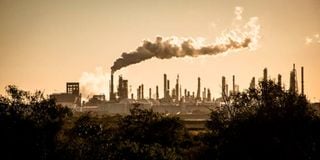15pc of all lung cancer deaths caused by air pollution

A cloud of smoke rises from an oil petroleum refinery. Air pollution is a major problem affecting the world, and its effects on health are alarming. It is essential that nations impose strict regulations to control the release of pollutants into the atmosphere.
What you need to know:
- According to UICC experts, only one per cent of the world’s population or about 80 million people out of eight billion, breathes air that does not exceed air quality limits.
- They further observe that air pollution currently contributes to 6.7 million deaths annually, matching the mortality rates seen during the peak years of the Covid-19 pandemic (2020 and 2021).
A new report has found that air pollution is responsible for 15 per cent of all lung cancer deaths. “Exposure to air pollution can lead to cancer, stroke, respiratory, cardiovascular diseases and other health issues – similar risks as those associated with smoking tobacco; while low-income countries account for 92 per cent of pollution related deaths, “ notes the report by the Union of International Cancer Control (UICC) .
As Kenya works to lay out the legislative framework for air quality management (the Nairobi Draft Air Quality Bill) and develops a roadmap and strategy for adopting the bill, UICC also notes that the global health damages associated with air pollution are estimated at a staggering USD 8.1 trillion, or 6.1 per cent per cent of global GDP.
According to UICC experts, only one per cent of the world’s population or about 80 million people out of eight billion, breathes air that does not exceed air quality limits.
They further observe that air pollution currently contributes to 6.7 million deaths annually, matching the mortality rates seen during the peak years of the Covid-19 pandemic (2020 and 2021).
Dr Sonali Johnson, the head of Knowledge, Advocacy and Policy at UICC, is of the view that creating cleaner and greener environments to reduce air pollution is about fostering conditions that encourage more active, healthier lifestyles, further lowering the risk of various cancers and non-communicable diseases.
“Indeed, air pollution is threatening progress being made in reducing the burden of cancer worldwide by contributing to the rise of the number of cancer diagnoses each year – cancers that are preventable.
“Implementing measures such as fostering the transition to renewable energy, promoting public transportation, bicycling and walking, increasing green spaces and strengthening pollution control policies can significantly reduce air pollution,” she says while observing that not only do these actions directly lower the risks of developing cancer and other diseases by reducing exposure to harmful pollutants, but they also indirectly promote better health by creating environments conducive to physical activity.
“This is why IUCC calls on the global health community and policy makers to recognise the correlation between environment and health.”
In an interview with Healthy Nation, Dr Bethwel Mutai, a consultant air quality meteorologist at the Food and Agriculture Organization, agrees with Dr Sonali: “Indeed, studies have conclusively demonstrated that air pollutants (and weather) are linked to the prevalence of human respiratory diseases particularly asthma, pneumonia and upper respiratory tract infections such as rhinitis, pharyngitis, tonsillitis and laryngitis.
“Pollutants themselves are not causative agents; rather they exacerbate and in which case, management of human respiratory health becomes problematic in the advent of human/urban induced release of industrial pollutants and urban migration and urban crowding all in the advent of climate change will in turn lead to enhanced levels of pollutants like pollen, which are temperature sensitive,” he said.




